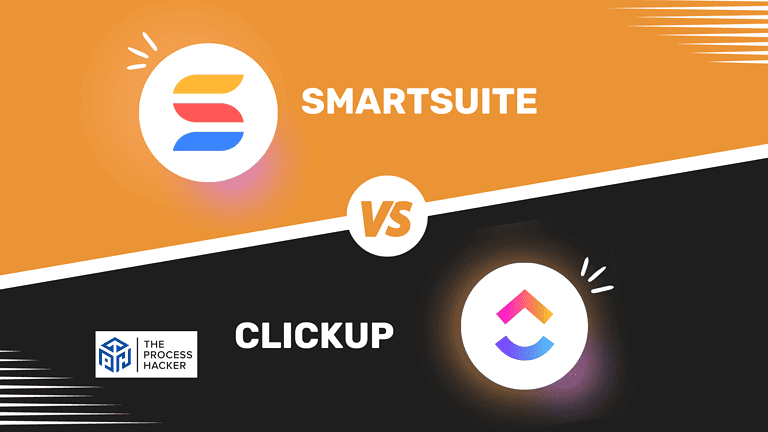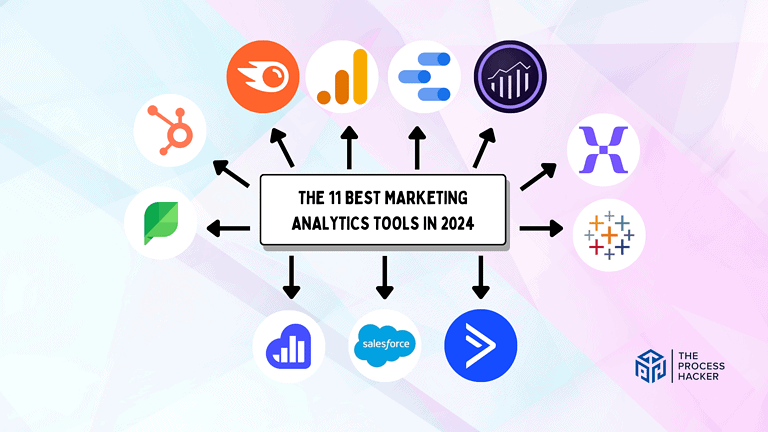Radical Focus by Christina Wodtke | Summary
In Radical Focus, Christina Wodtke describes the Objectives and Key Results (OKRs) approach to goal setting and achieving. An OKR is “a focused goal, both inspiring and measure, traced regularly.”
In an unfocused word, Wodtke relies on here Silicon Valley experience to practically help you implement specific OKRs in your business. For more information about Christina Wodtke, you should check out her website.
Buy Radical Focus on Amazon
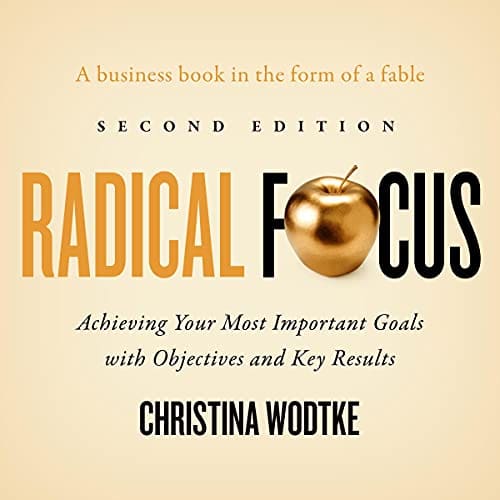
Radical Focus by Christina Wodtke
Achieving Your Goals with Objectives and Key Results
Download the PDF Book Summary for Radical Focus by Christina Wodtke
The Executioner’s Tale
Christina Wodtke starts Radical Focus by narrating a fictional story about Hanna and Jack’s small tea supply company that almost failed. The founders had big dreams to grow their startup and initially hoped that things would work out. However, Hanna and Jack struggled and received an ultimatum from their sole investor to make significant changes.
Thus, Hanna and Jack learned how to use Objectives and Key Results (OKRs) with Christina Wodtke’s Radical Focus to get the right things done. Implementing OKRs transformed them from dreamers to executers. The story illustrates how they inspire a diverse team to work together to accomplish a specific, challenging goal and maintain motivation despite facing obstacles and failures.
The Framework
In this section of Radical Focus, Christina Wodtkgrae provides the surrounding framework for OKRs. She believes there are five reasons why we can’t get the essential things done:
- We haven’t prioritized our goals. “If everything is important, nothing is important,” so focus on your most important goal and avoid being unrealistic by trying to accomplish everything. Further, “clarify conceptualizing that goal: What does it look like, when is it accomplished, what exactly do you want?”
- We haven’t communicated the goal obsessively and comprehensively. LinkedIn CEO, Jeff Weiner, has said: “When you are tired of saying it, people are starting to hear it.” Therefore, “state that clear, conceptual goal in all messaging, over and over, until everyone understands and pursues it.”
- We don’t have a plan to get things done. We often lack a strategy and incorrectly rely on willpower to succeed. Instead, “make a plan that will keep you moving forward, even when you are tired and disheartened.”
- We haven’t made time for what matters. President Eisenhower has said: “What is important is seldom urgent, and what is urgent is seldom important.” Instead, implement the Eisenhower Matrix and “dedicate time to accomplishing the goal, instead of endlessly hoping for a tomorrow that never comes.”
- We give up instead of iterating. Many people fail during their first implantation of the OKR methodology. “Be ready for failure, ready to learn, and ready to try again.”
Part One: The Fundamentals of Objectives and Key Results
In Part One of Radical Focus, Christina Wodtke discusses the fundamental concepts of using the OKR methodology, even if you are in a small startup or a team within a larger organization. You can become successful with OKRs.
Why Objectives and Key Results Matter
The OKR methodology focuses on thinking about the outcome instead of the output:
Objectives and Key Results (OKRs) – “a goal setting and achievement methodology that is used to focus a group or individual around a bold goal” or Objective:
Objectives – “establishes a goal for a set period of time, usually a quarter” that is qualitative, inspirational, time bound, and actionable by the team independently
The Objective is quantified into one to five (typically three) Key Results:
Key Results – the measurable outcomes that “tell you if the Objective has been met by the end of that time;” examples include growth, engagement, revenue, performance, and loyalty
Establishing Key Results
You can formulate Key Results by following these steps:
- Use the Free listing technique to brainstorm and list Key Result ideas for your Objective on sticky notes.
- Manipulate the sticky notes by rearranging, disposing, or rewording as needed.
- Rank the metrics based on those that will best indicate progress.
- Determine the potential consequences of the Key Results.
Ask yourself the following when establishing Key Results:
- Do you have a baseline? If you do not have a baseline level for a metric, track it for at least a month before elevating it into a Key Result.
- How easy is it to measure? Avoid assigning Key Results to easy to measure outcomes that will not have much effect on the Objective.
- Is it a strong signal or a weak signal? The Key Results should strongly indicate progress toward the overall Objective.
- How confident will you feel if this number is met? To achieve major Objectives, you need to make your Key Results difficult but not impossible.
Avoid turning a Key Result into a project, as it commits you to outputs instead of outcomes. If you spot a task or project listed as a Key Result, ask yourself the following to determine better metrics that focus on the outcome:
- Why this project? Why is it important?
- What will it accomplish? What will change?
- How do you know if it’s successful?
- What numbers will move if it works?
- How does that tie into the company’s Objective?
Prerequisites for OKRs
OKRs are supposed to provide your employees the freedom to determine the work to get the desired outcomes. Therefore, there are several prerequisites for establishing Objectives and Key Results in your company:
- Check Your Mission: Create a concise, meaningful mission to help you navigate your entrepreneurial journey using this simple formula: “We [reduce pain/improve life] in [market] by [value proposition].” Mission statements guide your vision for the long-term, while OKRs provide focus and milestones for a year or quarter.
- Establish a Strategy: Instead of reacting and wasting resources, develop your strategic activities or “planned efforts to gain traction in the market.” Initially, startups should implement a strategy to achieve product-market fit or get their “product to satisfy a strong market demand.” After that, there should be a strategy for growth.
- Practice Metrics Thinking: The book, Lean Analytics, states that a good metric is comparative, understandable, a ratio or rate, and changes how you behave. The OKR methodology requires moving metrics, so you should have your employees understand the most critical metrics. Initially, a baseline may need to be established.
- Provide a Safe Place for Teamwork: Create a supportive and safe environment to bring your people together into effective teams. Also, leaders must unite and provide space for members to discuss professional and personal topics. Further, you should create Team Charters to create rules of engagement to foster team communication.
Download the PDF Book Summary for Radical Focus by Christina Wodtke
Supporting OKR Management
All your project ideas should get moved into your pipeline:
Pipelines – “a collection of ideas of projects that might get us to our desired future that use impact/effort/confidence to prioritize the best ideas”
Pipelines provide flexibility by allowing leaders to determine which efforts will be the most effective or ask for further research in decision making.
Further, there are administrative and operational efforts in your business that do not make you money but still require monitoring. As radical improvement is not needed, these activities do not require OKRs but will be tracked by Health Metrics:
Health Metrics – key performance measures that indicate overall business health using colors:
- Green: Everything is fine.
- Yellow: Warning to watch out.
- Red: Something is negatively affecting the business, which notifies the management.
These metrics allow managers to spot neglect of standard business activities in pursuit of overambitious OKRs. Examples include customer sign-ups, customer satisfaction, code health, and team health. Sometimes, you may need to promote a declining Health Metric into an OKR.
The Cadence to Make OKRs Work
In Radical Focus, Christina Wodtke argues that the regular cadence of meetings results in progress and OKR achievement. There should be two critical 1-hour meetings to create the cadence every week: one on Monday to set intentions and one on Friday to celebrate progress.
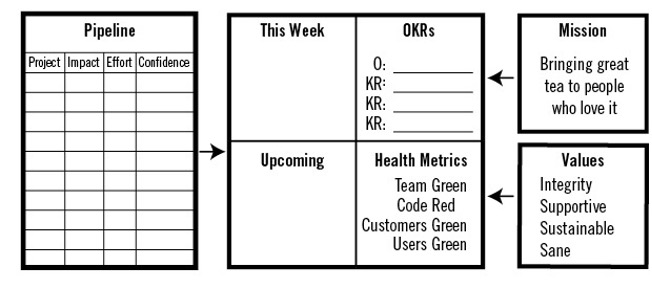
Monday Commitments: On Monday, the team should meet to check OKR progress and commits to the tasks that move the company toward its Objective. The following format with the four key quadrants should be used:
- Intention for the Week: What are the three most important things you must get done this week for the Objective? Discuss if these priorities will move you toward the OKRs.
- Forecast for the Month: What should your team know is coming up that they can help with or prepare for?
- Status toward OKRs: If you set a confidence level of five out of ten, has it moved up or down? Discuss why this may be the case.
- Health Metrics: Pick two to five things to protect and indicate business health as you strive toward success. Now, flag these metrics when they are poor, and discuss them.
Keep the review of the four-square short to observe both efforts and Objectives. As a leader, you should trust your team’s ability to accomplish their work. Further, provide support and help the team tackle issues including:
- Do the priorities lead to our hitting our OKRs?
- Why is confidence dropping in our ability to make our OKRs? Can anyone help?
- Are we prepared for major new efforts? Does marketing know what product is up to?
- Are we burning out our people or letting hacks become part of the code bases?
Fridays Celebrations: On Friday, the team should meet to share progress and celebrate wins. This meeting orients members to be prepared to have work done to share, seek wins, and understand what others do. Further, here are additional tips for your meeting:
- Hold at 3 or 4 PM as your team will be worn out and can go home on time.
- Do not require attendance.
- Budget for and provide food and beverages to make the team feel appreciated.
- For remote teams, conduct the meeting over video conferencing and have managers read aloud or email the top wins.
- Send out a short anonymous survey for improvement asking, “What should we keep doing? What should we change? What should the management team know?”
Improve Weekly Status Emails with OKRs
In Radical Focus, Christina Wodtke provides a simple format to improve your weekly status emails using OKRs:
- Lead with your team’s OKRs and convey confidence level. List the OKRs to remind the group of the why behind what you are doing. Provide how confident you are in hitting them this quarter to help track progress and correct course if needed.
- List last week’s prioritized tasks and if they were achieved. If they were not accomplished, state briefly why. This step conveys what keeps the organization from accomplishing what it needs to perform.
- List next week’s priorities. Only list three main priorities (P1s) that encompass multiple steps and potential accomplishments.
- List any risks or blockers. Communicate anything you could use help on, such as obstacles or issues that you cannot solve yourself.
- Notes. Add notes to cover anything that does not fit into the above categories but must be included.
On Radical Focus
Christina Wodtke titled the book, Radical Focus, because she wanted to bring attention to the concept of focus being the most critical factor in success. Specifically, it is necessary to take focused action on one company Objective. Additional OKRs create exponential complexity that slows down your progress. Christina Wodtke provides specific advice on Radical Focus.
- Don’t try to jam years of work into a single quarter. Avoid trying to do everything, as you will not accomplish much of anything.
- Don’t make a company OKR set for every department. An OKR needs to unite the company by having “one Objective to rule them all.”
- Not everyone will lead; some will support. The company OKR does not necessarily require everyone’s attention as some are in support roles.
- Don’t let politics distract you from clear, concise OKR sets. Avoid having members add personal goals to the OKR that are misaligned with it.
Download the PDF Book Summary for Radical Focus by Christina Wodtke
Part Two: Objectives and Key Results in Practice
In Part Two of Radical Focus, Christina Wodtke focuses on the implementation, exceptions, and variations of the core rituals of OKRs.
Implementing OKRs for the First Time
When implementing OKRs, you want to plan and provide training for your employees. In this section of Radical Focus, Christina Wodtke states that you will probably fail at first. Keep it simple so you can rebound from failure by starting with one of the following actions:
- Implement OKRs in One Team: Before introducing OKRs company-wide, pick an independent team that is capable and high-performing. Over a few cycles, support this team to be successful. Then, roll out OKRs to other teams or the whole company.
- Implement one OKR for the Entire Company: Keep it simple and set one company-wide OKR to hold your executive team accountable. The leadership team will work to a higher standard, and employees will see the effect of the OKR methodology. For more on leadership, check out The 5 Levels of Leadership (book summary).
- Apply OKRs to Projects: Train your people to have an Objective-Result mindset regarding each project. Continuously reiterate the Objective for a particular project and the metrics for what constitutes impact and success.
OKRs for Products
In this section of Radical Focus, Christina Wodtke features the story of GatherContent, which effectively used OKRs for products and specifically new features. The new features were formulated into a Minimum Viable Product (MVP).
Then, the Kanban system was used for scheduling and tracking MVP project completion on a Roadmap. Each Kanban card included the MVP’s “standardized description, requirements, and any additional notes and sketches.” Additionally, the team answers these two OKR questions:
- Hypothesis (Objective): What are we trying to achieve with this feature?
- Key Result: How do we measure success or failure?
The Hypothesis term emphasizes the experimental approach to product development. The hypothesis to be proved or disproved as OKRs do the following:
- Logic Upfront: Provide a ton of value to the other aspects of the process:
- Prioritizing Work: Help prioritize projects on the Roadmap based on impact.
- Connecting Outcomes: Align project results directly to outcomes for the entire business.
- Measurement and Learning: Measure quantifiable metrics to analyze and learn.
- Effective Communication: Develops communication as the team has to discuss results.
How to Hold a Meeting to Set OKRs for the Quarter
Two weeks before the end of the quarter, all OKRs should be graded. Then, in Radical Focus, Christina Wodtke recommends you run an executive meeting to set a companywide OKR or big rock for the quarter. She uses a design thinking approach, so follow these guidelines for the discussion:
- Schedule the meeting for four and half hours with a first 2-hour session, 30-minute break, and second 2-hour session. Ideally, the second session should not be needed.
- Keep the meeting small with less than ten attending people, specifically executives.
- Before the meeting:
- Ask all employees to submit Objective ideas and choose the most popular ones as this step gets company-wide buy-in for OKRs and insight into the culture.
- Have each executive come to the meeting with one to two Objective ideas.
- Gather supplies of large and small sticky notes and writing utensils.
The meeting should follow this agenda to determine OKRs:
- Remove Distractions: Maintain focus by having everyone leave phones and computers.
- Add Objectives (5 min): List all possible Objectives from employees and executives on large sticky notes on a board or wall.
- Discuss. Debate. Fight. Stack rank. Pick: With the possible Objectives, observe patterns, combine similar ones, debate them, and stack rank down to three options.
- Freelist Metrics (10 min): Write down as many possible Key Measures to measure each Objective with idea one per small sticky note.
- Affinity Map and Select: Group similar Key Measures, stack rank, and choose three Key Results. It is suggested that you have one metric for usage, revenue, and satisfaction.
- Set Values: Establish stretch goals for the Key Results that are exciting and challenging.
- Evaluate Work: Decide and discuss the final OKR set to check its inspiration, challenging, and relative.
After setting an OKR for the company, take the following steps:
- Executives’ Homework: Publish and introduce the quarterly OKR to direct reports to develop team OKRs. You can run a similar meeting to free list, group, rank, and choose.
- CEO Approval: Have the CEO spend about one hour with each executive to approve the team OKRs. There should be extra follow-up meetings if department head OKRs are off.
- Sub-Team OKR Development: Publish and provide the company and department OKRs to sub-teams to develop their own OKRs.
- All Hands Meeting: The CEO justifies the chosen OKR for that quarter, mentions some great departmental OKRs, and evaluates the last quarter.
Note that you should know about two weeks before the new quarter starts whether you succeeded or failed with your chosen OKR. Remember, the goal is to continuously observe, learn, and improve from the cycle of OKRs. Lastly, you will probably make mistakes the first time you set OKRs, so download this worksheet to make the process easier.
OKRs for Product Teams
In this section of Radical Focus, Christina Wodtke features the story of the Silicon Valley Product Group, which applied OKRs for Product Teams:
Product Teams – “a cross-functional set of professionals” that “is responsible for some significant part of the company’s product offering or technology”
The product teams solve difficult business and tech issues, which are communicated and tracked through the product team’s OKRs. The OKRs ensure alignment between the objectives of each team and that of the company.
However, team OKRs can be conflicting for an employee belonging to both a functional and product team. Therefore, in a product organization, you should focus OKRs at the product team level. These OKRs can then cascade up to the company or business unit level.
Cascading OKRs at Scale
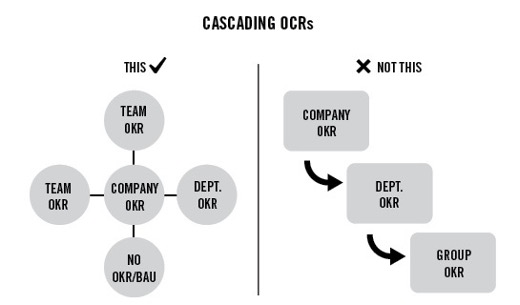
For smaller teams of less than 20 with one or two levels, cascading OKRs are fine. The executive team sets the OKRs, and then the product teams can establish theirs. However, for larger organizations, you should use aligning OKRs to avoid the slow waterfall of goals. You should trust and empower teams to use OKRs to determine how to achieve the desired outcomes.
Wodtke recommends that you set four Objectives for the year with only three Key Results for the first quarter Objective. You want to follow your long-term vision while keeping in mind that the Cone of Uncertainty principle states that “the farther we predict into the future, the less accurate our predictions become.”
Once company OKRs are set, provide 48 hours for all self-sufficient teams to establish their own as this encourages action over perfection. During this time, teams should observe others’ actions, get feedback, and revise accordingly. Lastly, the potential OKRs can be reviewed and discussed with the direct managers.
When your company grows, OKRs can scale with it without inaction by doing the following:
- Hire great people
- Establish specific outcome-based goals (check out SMART goals)
- Give up control of tactics to achieve company goals
- Trust your teams
OKRs and the Product Portfolio
In large companies, you must determine who will and will not need to use OKRs. You can start with a company’s product portfolio from Boston Consulting Group:
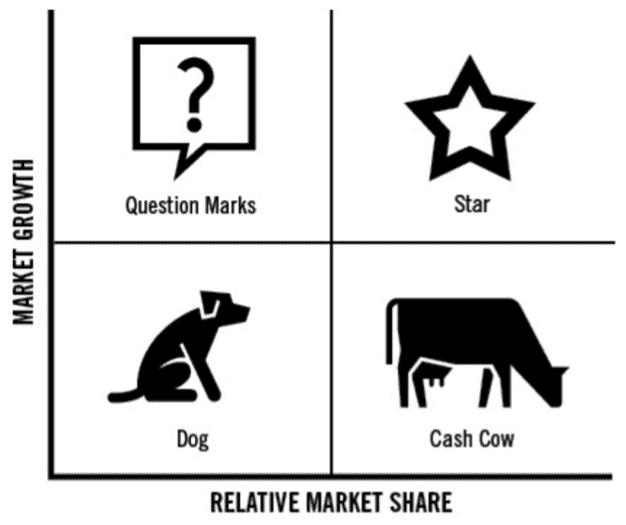
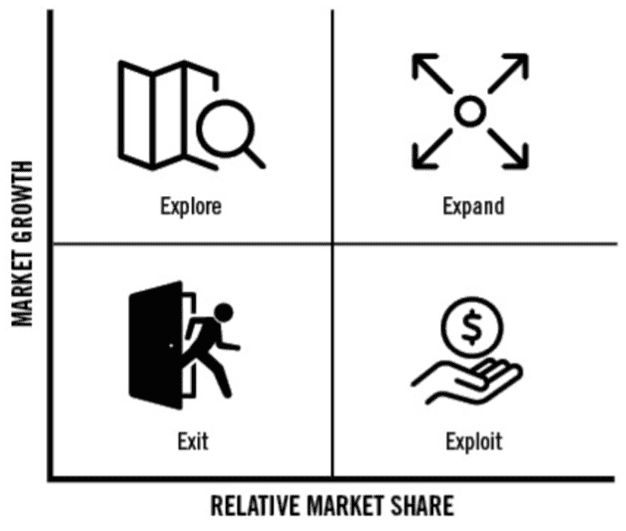
In the first diagram (left), your products and services should fit into these quadrants, with the second diagram (right) showing whether you need OKRs:
- Question Mark: Explore this growing market using Exploratory or Hypothesis OKRs even though you may not have a product.
- Star: Expand your successful products and services in this growing market and use traditional OKRs.
- Cash Cows: Exploit your money maker but avoid using OKRs as there is no room to grow within the saturated market.
- Dog: Exit this fading market with your product success and do not use OKRs. Instead, possibly automate and defund it.
Do not use OKRs on shrinking markets because it is sad to ask people to do the impossible, and your people may cheat to win. Instead, managers should create realistic, stretch goals to have employees work to their best. For service departments, you should probably not use OKRs as these groups support product teams.
Lastly, for individuals, you should definitely not have OKRs as they are demotivating and micro-managerial in nature. In The Team that Managed Itself, Christina Wodtke provided a simple Role Canvas to use for hiring:
Role Canvas – a visual worksheet that helps you think through hiring, managing, and reviewing your employee’s work:
- Define the Role: Fill in the Role Canvas with the four parts of the role:
- Responsibilities – “the steady-state activities any job has”
- Goals – the objective asked to achieve that is aligned to the company OKRs
- Market Knowledge – “how well a prospect knows the space your company operates in”
- Skills – “refers to the hard and soft skills it takes to accomplish the job”
- Interview and Role: Look over the Role Canvas to enter questions at the bottom to “use them as a guide to evaluate your candidates.”
- Manage Using the Role Canvas: Review the Role Canvas before weekly one-on-ones to evaluate the four areas and then choose the most pressing issue to discuss.
- Evaluate and Give Feedback:Use the Role Canvas to provide quarterly performance reviews by prepping from weekly reports and meetings.
- Day of Review: Review your notes, get into an authentic frame and hold a coaching-style performance review. Then, get feedback for yourself and document the meeting.
Download the PDF Book Summary for Radical Focus by Christina Wodtke
OKRs and the Annual Review
In this section of Radical Focus, Christina Wodtke features the story of Workboard, which “enables and sustains OKRs, brings goals into people’s day-to-day work focus, and provides continuous and cross-organization transparency.” The company advocates for goals driving business performance instead of performance reviews driving goals.
How Do We Restore the Magic Power of Goals? We reframe the goals from purely evaluating performance to having inspiration and excitement using these five steps:
- Use Goals to Define and Drive Success so your people can have permission to focus on the most critical tasks.
- Dump the Old-School Goal Model for One that Amplifies Results by aligning OKRs with the best-case scenario and disassociating them from performance reviews.
- Manage Achievement in Real-Time to help your people keep focused on the goal, predict outcomes easily, and be held accountable.
- Make Goals as Present as Email by allowing team members to find their goals and understand their progress quickly.
- Goals Should Flow Top-Down and Bottom-Up to have convergence and promote ideas and innovation from everywhere in the organization.
How Do You Assess Performance and Decide Who Gets Pay and Promotions? You should have continuous, transparent one-on-ones twice a month to calibrate engagement, performance, and alignment.
Tracking and Evaluating OKRs
In this section of Radical Focus, Christina Wodtke recommends that you grade your OKRs and create a new quarterly plan about two weeks before the end of the quarter. The two common systems for evaluating OKRS are Confidence Rates and Grading:
Confidence Ratings – a scoring system used for small and startup organizations that establishes difficult metrics with about a 50 percent confidence in achieving
During the Monday commitment meeting, team members should report changes in confidence to keep goals top of mind. If progressing well, confidence will increase, while hindrances will lower confidence and trigger key conversations. About two weeks from the quarter’s end, you should know if the Objective will be achieved by making two out of three Key Results.
Grading – a quarter scoring system used for larger organizations that grades the results of teams and individuals from 0.0 (failure) to 1.0 (success) with a target range of 0.6 to 0.7
Lower than 0.6 means the organization is achieving below its potential, while higher than 0.7 indicates that the goal was not high enough. During the quarter, display progress charts and have check-ins to show progress, spur communication, and provide accountability. At the end of the quarter, OKRs should be publicly graded, reviewed, and established.
Remember that OKRs should not be solely used to evaluate performance for both methods. Instead, they can summarize quarter accomplishments and the overall impact on the company. Further, OKRs can guide review conversations and help determine bonuses and raises.
Beyond the Usual OKR Approach
There are three types of OKRs that can be useful to guide companies struggling to set OKRs:
- Exploratory OKRs – used to explore unknown ideas, possibilities, or technology; work well for early-stage startups or innovation teams
- Hypothesis OKRs – used to hypothesize and get the data to validate a strategy or indicate a need to pivot; work well for middle-stage companies
- Milestone OKRs – used to understand if your current efforts are working in the right direction and will be successful before committing to significant projects
“Decide what impact you want to have and then work toward that, measuring the entire way. Only then will you know when it’s time to pivot, when it’s time to quit, and when it’s time to double down. Use feedback from the real world to make a real difference.”
Use OKRs to Increase Organizational Learning
OKRs should foster organizational learning, as here are three ways to learn:
- Instruction – the weakest approach to learning, which involves learning by someone presenting in front of you
- Action – learning by doing, which “allows you to create a personal relationship with knowledge and learn practical skills”
- Reflection – the most important and powerful method of learning, which involves reviewing the past, determining lessons learned, and assigning meaning
Reflection is built into the cadence of weekly check-ins and quarterly grading. Every week, you create goals based on your OKR, test them, and reflect on them. The weekly and quarterly reflection reveals the actions taken, necessary course corrections, and guides learning.
In most fast-growing teams, everyone shares in the learning. However, your company may grow large enough to require formal events for cross-team learning, such as lunch-and-learns. Also, the Friday status email can facilitate cross-team learning by providing awareness and stimulating conversation about individual and team successes and failures.
Lastly, OKRs help teams and individuals adapt as the future can be uncertain. They provide the confidence to navigate changing industries and economies. The ability to learn will build knowledge, keep you agile, and help you adapt to changing situations.
Score Your OKRs It Is Worth It
In this section of Radical Focus, Christina Wodtke features the story of Magdalena Pire Schmidt, who shows you how to score your OKRs with two steps:
- Score each Key Result from 0 to 1.
- Obtain the Objective score from the average of the Key Results.
You should score quantitively as it helps:
- Improves the Quality of Your Key Results: Establish better Key Results that are specific, meaningful, measurable, and easily communicate the outcome.
- Face Reality: Provides quantitative, transparent truths that can raise awareness, highlight successes and failures, facilitate changes, and foster communication.
Focus on scoring results, not strategies or initiatives, as this will help you be more innovative, adaptable, and experimental. Here are various methods, with the last being recommended:
- Score Confidence – “assesses if the project(s) are on track or not to deliver on the result”
- Scoring Milestones – “provides an update of how much of the needed initiative(s) has been completed”
- Scoring Results (recommended) – “provides an update of the results seen so far”
Many avoid scoring OKRs throughout the quarter because it requires effort and may present bad news. However, score OKRs consistently to gain clarity and awareness over actions. By the last month, the team will have a great idea of success or failure and an idea of where they stand. The final score can be interpreted as follows:
- Score 0.7–1.0: Achieved / Green
- Score 0.31–0.69: Partially achieved / Yellow
- Score 0–0.3: Not achieved / Red
This scoring interpretation incentivizes setting ambitious OKRs as above 0.7 is considered a success and above 0.3 is progress. However, if a team is consistently scoring above 0.7, then they are making OKRs too realistic and not being challenged.
“At the end of the quarter, reflect on the whole: the OKRs scores, the business-as-usual and KPIs, team events, new challenges, and opportunities of the past quarter.” Maintain a running document for these sections:
- Highlights – “great results on projects and business-as-usual”
- Groundwork – “areas where we made progress, put in a lot of effort, but have not seen results yet”
- Lowlights – “areas where we didn’t make progress or new challenges that emerged”
In the end, the score informs the narrative and understanding but will not be remembered. Instead, the legacy will be about “what was our impact, and where are we going next?”
A Note on OKR Software
There are many OKR tools that exist, but at first, keep it simple, experiment, and try these tools:
- Whiteboard: “To write ideas of what your Objectives will be.”
- Sticky Notes: “To brainstorm good KRs.”
- PowerPoint: “To track confidence and efforts against the Objectives.”
- Email: “To send statuses out.”
- Excel: “If you decide you wish to do formal grading.”
Download the PDF Book Summary for Radical Focus by Christina Wodtke
Simple but Hard Conclusion and Next Steps
Christina Wodtke concludes Radical Focus by stating that OKRs “are simple but hard. … To be successful, you have to focus on what matters. You have to say no a lot. You have to check in with your team and hold people accountable to their promises. You have to argue about whether or not your tactics are working and admit when they aren’t. There isn’t much complexity to OKRs, but they take quite a bit of discipline to do well.”
When you use the power of OKRs as described by Christina Wodtke, you can get Radical Focus to achieve significant goals in your business. Therefore, I hope you are inspired to get your own copy of Radical Focus by Christina Wodtke. If you are just starting out as an entrepreneur, check out Entrepreneurial Leap (book summary) by Gino Wickman.


